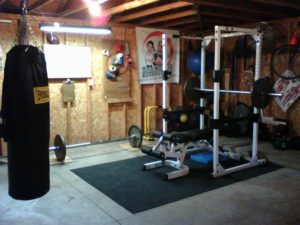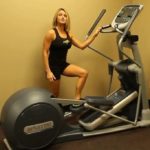Many gyms closed during the pandemic, leaving their patrons high and dry. Home gyms exploded in popularity. Today, with public gyms still not very safe, a home gym remains worth considering for safety reasons.
At any time, it’s a huge convenience; your home gym is open 24 hours a day, you don’t have to drive to get to it, or wait your turn to get on equipment you want to use. There are no conflicts with other gym users, and because it’s super-accessible you’re more likely to stick with a regular workout routine.
For some people workouts are an activity, for others a necessity. If you have a serious weight problem, which can cause a host of other health problems, it will take a combination of diet and exercise to bring it under control.
A home gym requires three things: Space, money, and determination. The latter because a gym is useless if you don’t use it. For many people, working out isn’t fun, so sticking to a regular exercise routine requires self-discipline.
If you’re doing it to lose weight and resolve weight-related health problems working with a doctor, nutritionist or dietician, and trainer helps you go about it in the right way and reach your weight-loss and health-restoration goals.
 Let’s be realistic: Unless you’re a professional athlete or movie star, your gym probably will look like the photo at left, not the photo at bottom. Now let’s tackle the details.
Let’s be realistic: Unless you’re a professional athlete or movie star, your gym probably will look like the photo at left, not the photo at bottom. Now let’s tackle the details.
Space: A room of the house that’s heated and air conditioned is better than an unheated/uncooled garage or shed, as it will be usable year-round.
A room too cold or too hot won’t be very tempting to spend long hours in, so try to find a room with controlled temperature. Best is a basement rec room, which has more space, and a concrete floor to support the weight of the equipment. If you only have an unheated outbuilding, you can make it more comfortable by installing insulation, a space heater, and windows that open for ventilation.
Money: There’s no way a home gym saves money compared to gym fees. Good equipment is expensive. You won’t recover your costs in saved gym fees. This is a luxury expenditure. However, creative accounting makes the outlay more palatable. If you spend $20,000 that otherwise earns 3% interest, your true cost is loss of $600 a year of income, or $50 a month. Compare that to gym fees.
You get what you pay for. My advice is don’t buy cheap consumer-grade junk. It will break down, and you won’t use it. Go for quality.
Perhaps the safest way to buy gym equipment, if you don’t know anything about it, is to shop for brands you see in commercial gyms. They need reliability and equipment that can take hard use. In the Seattle area, a top brand is Precor, supplier to many commercial gyms; see their products and prices here. Some of the other manufacturer brands favored by commercial operators are listed here.
As for pricing, Precor’s top-of-line treadmills, the 800 series used in many commercial gyms, start at $9,000. But you don’t have to pay that much. Like other gym equipment manufacturers, Precor offers product lines for home use. For example, in treadmills, stepping down to their 700 series (starts at $7,500) or 600 series (starts at $5,500) is fine for a home gym. These are still heavy-duty, robust machines.
In general, cardio equipment is more expensive than weight apparatus, because it’s more complex while weights are relatively cheap to make.
How to not break the bank? There’s a used market. Many commercial gyms lease equipment, and when it comes off lease, it’s reconditioned and sold at far below new prices, similar to the car leasing business. This can be a great way to buy exercise bikes and weight machines at 33% to 50% off new prices. The best way to tap the used market is go to an authorized dealer and ask their staff if they know who sells used gym equipment in the area. They may have a used outlet of their own. That’s the case with Precor in Seattle, which has a retail store in Lynnwood and a used outlet in Southcenter.
Availability depends on the leasing cycle, and some items can be hard to find in the used market. This is generally true of big, expensive items like treadmills. A treadmill, which has a motor and moving parts subject to wear and tear, is worth buying new for the warranty against expensive repairs.
You can also find used gym equipment on Amazon and from various online sellers, but buying through those sources is tricky and fraught with potential problems. You don’t know what you’re getting in terms of its history or what shape it’s in (would you buy a used car online, sight unseen?), the freight charges are substantial if it has to be trucked across country, and all the freight company does is drop a 500-lb. crate in your driveway; from there, you’re on your own. It’s better to deal with a local business that can handle everything from purchase, delivery, and setup to post-purchase repairs and service. A local salesperson is invaluable when you need someone to talk to. A seller 1,500 miles away doesn’t care once they have your payment.
Creating a home gym is a major project that will require months of planning, effort, and problem-solving. A lot of people who formerly used commercial gyms are going this route now, so demand is high, and the supply chain isn’t functioning normally. Some products are unavailable or backordered, and delivery times can stretch to weeks or longer (that’s improving, but not all the way back to normal).
There are significant logistical hurdles to overcome; the crates are big, bulky, and heavy, and the products may require assembly. One person can’t move this stuff; that requires a crew with proper dollies and equipment, and strong young backs. Don’t risk injuring yours. Delivery and installation is a job for professionals, and doesn’t add much to costs; most of the money is in purchase costs. And these guys have an eye for the best room layout of the equipment. An authorized dealer can arrange delivery and setup for you. A treadmill may require dedicated wiring that has to be installed by a licensed electrician, although a standard 15-amp household outlet seems to handle a Precor 631’s 3-amp motor without problems.
Large items may not make it through your doorways and hallways. Study the specs (dimensions, weight, power requirements). Be wary of any turns on the route; a 7-foot-long treadmill platform may make not make it around a tight corner.
 Most likely to be problematical is a large elliptical. A Precor 800-series treadmill can make it through doorways and hallways a Precor elliptical (photo, left) can’t. If you’re installing your gym in a garage, no problem, that’s easy. If in a ground-level rec room, you’ll probably need a sliding patio door to the outside to get it inside. Upstairs? Forget it. Smaller ellipticals are available (although not from Precor). Or you could just do without one, and save a lot of money that way, too.
Most likely to be problematical is a large elliptical. A Precor 800-series treadmill can make it through doorways and hallways a Precor elliptical (photo, left) can’t. If you’re installing your gym in a garage, no problem, that’s easy. If in a ground-level rec room, you’ll probably need a sliding patio door to the outside to get it inside. Upstairs? Forget it. Smaller ellipticals are available (although not from Precor). Or you could just do without one, and save a lot of money that way, too.
Those frame-like “multi-gyms” and “functional trainers” shouldn’t be a problem, because they come in pieces not much harder to maneuver through doors and hallways than a sheet of plywood or a stack of 2x4s.
Not only does the floor need to support the weight of all the equipment in your home gym, but you also want to protect it. I recommend using interlocking rubber floor tiles like these under the equipment. In a garage, you may want to take a look at something like this garage service that can install epoxy floor coatings for you. These types of flooring are durable and impact-resistant.
A trainer-designed workout likely will include stretching and floor exercises. A 2′ x 4′ x 2″-thick mat works great for that. You probably don’t need bigger. Dumbbells in graduated weights like these from Amazon also are a much-used accessory for well-rounded workouts.
What’s a reasonable budget? That depends on how extensively you equip your gym and how much quality you buy. I’m guessing an adequately equipped gym with a mix of cardio and weight, and new and used, commercial-grade equipment can be done for $10,000 to $15,000; and that figuring out where you’re going to put it, preparing the room, and getting everything purchased and installed very likely will take 4-6 months or longer. This isn’t a weekend project in the best of times, and these aren’t the best of times, although timelines are better now than in 2020 and 2021.
When this article was originally written in early 2021, it included the following language:
A question comes up whether, if the goal is to have access to a gym during the pandemic while public gyms remain closed, is it worth the expense and effort, in that the population should be vaccinated and things could be returning to normal by the time your home gym is up and running?
I would answer this way: We don’t know when, if ever, life will return to normal. We can hope by the end of this year, but I wouldn’t take anything for granted. What if the virus mutates in a way the vaccines don’t protect against? Any timeline for putting the virus in the rearview mirror is speculative. A home gym is an insurance policy against the reopening of public facilities going off the rails.
In any case, the pandemic is just an added reason to consider the idea of a home gym; the larger picture is whether it’s a luxury and convenience you can afford, and are willing to pay for, taking a long-term view that looks past the pandemic.
Some of those questions can now be answered. Presently, in July 2022, we are again threatened by a Covid-19 variant (called BA.5) that defies immunity from vaccines and previous infection, and while lockdowns are surely a thing of the past, we’re being advised to wear masks indoors again — and public gyms are obviously not a good place to be. And there’s no end in sight to Covid-19’s parade of variants. So we still don’t know when, if ever, life will return to normal. That reason for a home gym remain about as valid as it ever was.
Further thoughts: A gym (whether public, commercial, or at home) is necessary for structured workouts (as when working with a trainer), and can substitute for outdoor exercise like hiking (which can be simulated by watching hiking videos on a tablet computer while walking on a treadmill) in bad weather or when getting outdoors isn’t possible for other reasons (e.g., time).
Related: A new study suggests the long-established benchmark of at least 150 minutes of exercise a week isn’t enough; see article here.
